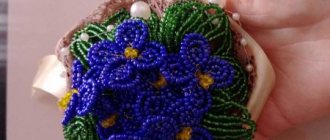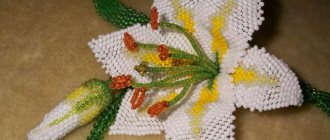How to weave a grapevine from beads
Prepare the following materials:
- blue and green beads;
- thin diameter copper wire;
- thick wire;
- scissors with nippers;
- green threads for winding the stem;
- ribbon for floristry is also green.
Bunch of grapes
Weaving the berries is done using the voluminous French technique. You need to cut four wires, each thirty centimeters long. Twist them into a bundle with an extended working wire.
Look at the step-by-step photos and weave, repeating their actions. String one bead and make a revolution around the axis, then string another bead again and repeat the turns.
Continue with similar steps.
As you work, you should increase the number of beads in the rows. You must do this evenly and without gaps between the glass and the wire. When you weave five rows, you will get an element in the form of a cap, as shown in the photo. Watch what you are doing, as the grape harvest should be in the shape of a ball. After the seventh day make decreases. In any case, creativity is encouraged. Before closing the grape completely, fill its interior with blue threads. Once this process is complete, twist the edges of the wire and wrap them with green thread. The winding can be fixed with PVA glue for greater strength.
Forming mustaches
For the antennae you will need two pieces of wire, twisted in the shape of a slingshot. They need to be wrapped with emerald thread. Then take a knitting needle and wind the ends of the workpiece onto it. As a result, you will get a curl that looks natural.
Leaves for grapes
The grape leaf is woven a little more complex than the previous elements. For inexperienced craftswomen, such work may not be possible. It will be better if you train beforehand. So, you need to cut the wire and string four green beads on it.
Next you need to go back through 3 beads and tighten so that the main axis comes out twenty centimeters. You should make a buttonhole in a circle, put additional glass on the tip, overtake the central strip and make a turn around the central strip near the base.
The sheet is woven in the form of steps. String five more beads, then cling to the center of this element, make a turn and collect seven additional pieces. Go back down to the base of the leaf, make a turn and twist the step on the opposite side in the same way. After you manage to complete three steps, you need to create a ledge with a sharp tip, and then return back.
Without stopping your movements, continue to weave the grape leaf further along this pattern. Each new strip in the workpiece should be wider than the previous one. When you have made another sharp bulge, then start making the workpiece smaller. The photo shows this process in more detail.
We are finishing the work on the grape leaf. We need the large leaf to hold its shape, and to do this, make a frame from thick wire. Wrap it with thread and attach it to the back of the workpiece.
A bunch of grapes can be decorated in different ways. For example, place it in a clear vase or wicker tray. And of course, grapes can be made in the shape of a small tree, as shown in the photo.
Video: Beading grapes from beads
Source: https://rukodelnichaem.ru/derevo-iz-bisera/vinograd_bisera.php
Vine
biserok.org September 12, 2013 »
This beautiful bead work was made by Tatyana Ivanova. It is impossible to pass by such a masterpiece and I decided to add this MK to my website with the permission of the author. Many thanks to her!
The necessary materials for work can be purchased at https://handmademart.net:
— Beads No. 10 blue — Beads No. 10 green — Copper wire or the color of the beads 0.3 mm in diameter — Thick wire 1-1.5 mm in diameter for the frame — Wire cutters, scissors — Green and blue threads for winding the stems for stuffing berries - Green floral tape
Braiding grapes
The berry should be voluminous, so it can be woven using the French weaving technique with multiple axes. Cut 4 wires approximately 25-30 cm each, twist them together into a bundle using a working wire, which should be as long as possible. Now, guided by the visual photos, start weaving. We collect 1 bead on the working wire, make a revolution around the nearest axis, again collect 1 bead, make a revolution around the next axis and so on (photo 1-6).
As you work, increase the number of beads in the rows so that the increase is uniform and without gaps between the beads and the wire. After you weave 5 rows you should have a hat like this - photo 7. Now watch the size of the grape, tighten the row, don’t add too much, form the shape of a ball. After the 6-7th row, start decreasing, but of course everything depends on your idea and the desired size.
Before the hole narrows too much, do not forget to fill the berry with blue threads to match the color of the beads. When the grape is woven, twist the ends of the wires and wrap them with green thread. Glue with PVA glue to secure the winding.
Grape tendrils
Cut two wires, twist them together to form a slingshot shape, wrap them with green thread and twist the ends onto a pen or thick knitting needle, thus forming curls. Make several of these antennae, preferably so that they differ from each other, as shown in the photo above on the right. The author made them look like they were alive!
grape leaf
It is quite difficult to weave a grape leaf, so if you do not yet have experience in weaving such works, it is better to first practice on simpler works.
Beaded grapes
For the berry, we take four small pieces of wire on the axis and a slightly thinner working wire...
We string beads onto the working wire.
Finding the middle of the axial wires...
and connect them at this place with the end of the working wire.
We slightly twist the axles and the free end of the working wire together...
We separate a couple of axial ends and cut off the rest.
We spread the axes crosswise and fasten the working wire one turn on one of the axes.
Let's start stringing beads...
- between axes.
First one at a time...
- gradually increasing the number of beads.
- View from the inside.
We are gradually forming a dome. Side view.
When the berry reaches the desired size...
- We begin to gradually reduce the number of beads in each row.
When the berry is almost formed...
We take knitting threads, preferably of a suitable color...
- and stuff the berries with them.
- This will give the berry a better shape.
Let's finish the berry...
- and twist all the wires tightly together.
- We cut off the extra axes.
- We wrap the stem of the berry with floral tape, then with thread.
- The berry is ready!
- We wrap the berries one to the other with a thread and form a bunch.
- I made three gronks of different sizes: 32, 27 and 18 berries.
For the antennae, I wrapped two long wires with floral tape, then with thread and connected them together. To prevent the base from being flat, I added a third short wire.
- Then she twisted her antennae in random spirals.
- These are the mustaches I got!
- Let's start making a leaf. Description of the work in the comments to the photo
We make a turn of low beads around the needle. Then all the work will go on the outer arcs.
- We begin to form the top of the segment
- Here we will make the first clove
- In the central segment we make the cloves approximately symmetrical
If you strive for naturalness, then there should not be complete symmetry... so we begin to show imagination in the formation of teeth
- Now we form the remaining part of the segment, gradually reducing the number of beads in the arcs.
- The central segment is ready!
- We begin to do the second segment similarly to the first.
- Top of the second segment.
Next, we collect five beads onto the working wire...
we bring the top of the second segment to the first-central segment...
- and connect them together through the bottom.
Here we pass the wire through the nearest bead of the finished segment, to make the work more accurate...
- We will do such passes of wire through one or two beads throughout the entire work, on all sides of the finished segments.
- We make a transition part to the axis of the second segment.
- On this side we also pass the wire through the required number of beads.
The transition part is ready. Now the work will go on one side on the outer arcs of the second segment...we make an arc...
- This is done in cases where the transition part is too large.
- We continue working until the end of the second segment.
- The second segment is ready!
- We make the top of the third segment.
We also add five beads to the working wire...
- and connect the top of the third segment with the central segments, on the opposite side.
Let's do the transition part. Here it turned out to be less convex and there is no need to level the work. We finish the third segment similarly to the second.
- The third segment is ready!
- We make the top of the fourth segment.
- We connect it with the free side of the third segment, without additional beads.
- The fourth and fifth segments are made without a transition part.
- We complete the fourth segment.
- We make the top of the fifth segment.
- We also connect it with the main work and complete our work.
Our leaf is almost ready...
- All that remains is to strengthen the axle.
One more point, because... I work with Chinese beads; personally, all the leaves are slightly different.
- To strengthen the axle you will need thick wire, floral tape and thread.
- I wrapped each wire with tape, then with thread and assembled this frame.
- We will strengthen our leaf with this frame.
- To make it easier to wrap the leg, we bend the lower edges of the leaf.
- We strengthen all the axes in two or three places, fixing the knots with super glue or varnish.
We cut off the excess threads. Our leaf is ready!!! View from the inside.
- This is what I got, now I need to grow a vine from all this.
Source: https://www.family-port.ru/Biser7.html
All Hand-Creativity: Grapes made of beads. Master Class
Beaded grapes. Master Class
Beaded grapes, master class on how to weave leaves and berries in parallel weaving.
From such a vine you can make very beautiful beaded compositions.
To weave grapes from beads you will need:
small blue beads; small green beads; wire for weaving; thick wire for creating a vine.
Beaded grapes master class with step-by-step photos of each stage of weaving.
First we will make a bunch of grapes. Cut the wire 15 cm. Make a cross.
The bead in the middle is parallel weaving, the side beads are simply strung on the ends of the wire.
You need to make 5 crosses on each wire.
Pass the ends of the wire through the first bead to close the chain into a circle. Twist the ends. The result will be a grape berry. For each bunch, 15 grapes are made. The grapes are collected into a bunch in a cascade to make it look like this. Beaded grape leaves are woven using a parallel weaving pattern. One sheet consists of 5 parts. 1 largest and 2 smaller ones.
First, the largest sheet is woven, then the side sheets, which are woven to the first one from the 7th row. Then the smallest ones, which are woven into the side leaves.
Grape beads leaf weaving pattern
The grape bunches and leaves are screwed alternately onto a thick wire. Wrap the vine with tape or brown floss. When copying an article, a link to the original is required!
vse-rukotvorchestvo.blogspot.com
A bunch of grapes made of beads. Part 1 – “Berries”
Grapes are a true gift of nature. Who doesn’t love to feast on its delicious berries, savor various types of wine, and admire this beautiful plant with an intricate interweaving of branches and outlandish carved leaves.
Nature did a great job by creating a grape bush. In its shade you can relax in the summer heat, and closer to autumn the fruits ripen - bright berries that increase vitality.
Many artists have depicted grapes, but recreating grapes from beads, as Valery Smyk did, is by no means easy. But we will try, especially since we have detailed instructions. So let's get started!
- To create this natural masterpiece, we should prepare:
- – small blue and green beads;
- – thin wire for weaving, thicker wire for forming the frame of leaves and berries, thick wire for the stem;
- – filler (cotton wool, thread, padding polyester);
- – florenta;
- – materials for decoration (plaster, paint, pot, stones).
- Since this bead composition is quite complex, in this master class we will look in detail at the technique of making grapes and form a bunch of grapes for our composition.
Grape bush. Assembly
To assemble grapes from beads with beads, you need:
- Create branches. To do this, take a wire with a diameter of 1 millimeter and cut 9 parts from it. They can be of different sizes.
- Wrap each one with green thread or cloth.
- Attach the finished parts to the branch. One branch should have four clusters and five leaves.
- When you're done assembling, tie everything to a thick branch.
- Glue it to a piece of wood.
The result is the sculpture “Grapes from Beads”. The master class described in detail all stages of creation.
Beaded grapes
- For work we will need:
- – green beads
- – purple beads
- – wire with a diameter of 0.3 mm
- – floral tape or green threads
- – wire with a diameter of 1 mm
- – a piece of wood
- - wire cutters or scissors
Let's start with weaving green grape leaves:
We will use the parallel weaving method, following the pattern, we will string the beads onto the wire. Each leaf is made of three halves sewn together to the middle of each leaf. We string the central leaf in parallel according to the following pattern: 1, 2,3,4,5,6,5,4,3,2,1. The two outer leaves are woven in the same sequence: 1,2,3,4,5,4,3,2,1. Let's weave 45 pieces of these leaves.
Let's continue weaving bunches of grapes:
The bunch of our grapes is all made of purple beads. Let's look at the diagram:
Let's tighten the wire:
We will also weave 14 more berries, after which we will collect a bunch of grapes from them.
First, take one berry and screw 4 more berries a little above it.
- Then we will screw on 6 more berries.
- Finally, screw the remaining 4 berries even higher - the bunch is ready.
- Let's collect 36 such bunches.
- Vine assembly:
Now let's start forming the branches. In total we will collect about 9 branches, they can be made of different lengths. Now let’s attach the clusters and leaves to the thick wire in the sequence shown in the diagram. Wrap each branch with floral tape or thread and we will form a vine of nine branches; we will also wrap the trunk with floral tape or thread to hide the wire.
And on our wood with a stand prepared in advance, we will wind all this beauty, we will get a beautiful grape branch.
Source: https://biseroplet.ru/vinograd-iz-bisera/
How to quickly and easily make a grapevine from beads
Today I want to show you how you can simply and quite quickly, even for a person who has not done beadwork before, make a grapevine, which can either become a gift in itself, or (if we limit ourselves to a few branches and bunches) serve as a pleasant addition to some your toy or other creative impulse. The technique is very primitive, but the result is quite spectacular.
To begin with, we stock up on materials - copper wire with a diameter of 0.4 mm (preferably green or brown), wire cutters (or scissors) for cutting it, a lint-free cloth (this “battlefield” still seems to me the most convenient for work), and also beads The latter is needed in only 2 colors - for bunches of grapes and for leaves. If you choose something petrol-iridescent for the fruit, like mine, try to find a green shade to match it (also iridescent and shiny), otherwise the berries will be discordant with the leaves.
Let's start with the more complex one - with grape bunches. We pour the beads onto a rag and start threading them onto the wire without cutting it off from the skein. For one bunch they are quite low, about 11-12 cm long.
We leave the tip of the wire equal to the approximate length of the “leg” of the bunch, and retreating this distance, decisively twist the loop of 8 beads.
We step back from the loop by about 6-7 mm and, without losing our determination, twist another loop, but this time from 7 beads.
We retreat to the same distance and, repeating the movements, alternately twist the loops of 6, 5, 4 and 3 beads. It turns out to be a kind of “small-small-less” chain.
We continue the chain according to the reverse principle of “many, many, more” - alternately twist the loops of 4, 5, 6, 7 and 8 beads, not forgetting to leave approximately the same distance between them.
We cut the wire from the common skein, leaving a tail equal to what was at the beginning. Fold the chain in half so that the smallest loop (of 3 beads) is centered on top.
We proceed to the most difficult part of the process to describe - we begin to twist this figure around an axis, simultaneously pressing it in and forming something similar to a bunch of grapes.
We continue until we achieve a result that is pleasing to the eye.
The bunch is ready, all that remains is to twist the wire tails to get a single stem. The estimated size of this wonder is about 2.5 cm. If you want to get something more monumental, start twisting with a loop of 11-12 beads, then also successively reduce the number of beads in the loop by one until you reach a loop of 3 beads , and move in the opposite direction. Further - and even easier. We spin as many of these things as we like (there are only 28 of them on my vine), and then we easily and happily draw the required number of branches (I have about 50 of them). The branches are made according to the principle of simple heather, the production of which I have already described in one of the tutorials here () The branches on the vine consist of 11 loops and are about 5 cm long. If you want more, we don’t deny ourselves anything, just we increase the total number of loops, remembering only that it should be odd. Having screwed in spare parts, you can:
a) stop and find direct use for them
b) proceed to the most creative part of the process - creating a full-fledged grapevine (then you will also need some highly artistic snag on which you can wrap it all; for me, for example, this is a pine branch found in a nearby forest). The assembly sequence in my case was as follows: 1. I wrapped a thick galvanized wire with brown copper so that it went behind the stem. 2. I randomly (but relatively evenly in quantitative terms) attached bunches and leaves to it. 3. I tied the vine to the branch (trunk), bending it accordingly (fastening was carried out with the same brown copper wire, a simple winding around the 2 connected parts in several places). In this photo on the left you can see the place where the “winding” was done.
4. The branch serving as the trunk was planted in a pot using plaster (at the same time, part of the wire base for the vine was also “buried” in plaster for stability). 5. I straightened and in some places curved the clusters and leaves in accordance with my taste perception of the composition.
6. I tried to artistically cover the plaster in the pot - I sprinkled it with fine sand of a pleasant color and added natural sesal fibers on top.
Agree, isn’t it difficult? Anyone who is not afraid that such a thing will serve as another “dust collector” in the house can begin to get creative.
Anyone who is not afraid that such a thing will serve as another “dust collector” in the house can begin to get creative. Others can give free rein to their imagination and find other uses for the vine - decorating cards, accessories for toys, etc. In the end, you can do nothing, but simply expand your handicraft horizons, noting to yourself that now you can easily do this if something happens... Be creative with pleasure!
Others can give free rein to their imagination and find other uses for the vine - decorating cards, accessories for toys, etc. In the end, you can do nothing, but simply expand your handicraft horizons, noting to yourself that now you can easily do this if something happens... Be creative with pleasure!
Grapevine Vegetables, fruits, berries – Biserok
This beautiful bead work was made by Tatyana Ivanova. It is impossible to pass by such a masterpiece and I decided to add this MK to my website with the permission of the author. Many thanks to her!
The necessary materials for work can be purchased at https://handmademart.net:
- — Beads No. 10 blue — Beads No. 10 green — Copper wire or the color of the beads 0.3 mm in diameter — Thick wire 1-1.5 mm in diameter for the frame — Wire cutters, scissors — Green and blue threads for winding the stems for stuffing berries
- — Green floral ribbon
Braiding grapes
The berry should be voluminous, so it can be woven using the French weaving technique with multiple axes.
Cut 4 wires approximately 25-30 cm each, twist them together into a bundle using a working wire, which should be as long as possible. Now, guided by the visual photos, start weaving.
We collect 1 bead on the working wire, make a revolution around the nearest axis, again collect 1 bead, make a revolution around the next axis and so on (photo 1-6).
As you work, increase the number of beads in the rows so that the increase is uniform and without gaps between the beads and the wire.
After you weave 5 rows you should have a hat like this - photo 7. Now watch the size of the grape, tighten the row, don’t add too much, form the shape of a ball.
After the 6-7th row, start decreasing, but of course everything depends on your idea and the desired size.
Before the hole narrows too much, do not forget to fill the berry with blue threads to match the color of the beads. When the grape is woven, twist the ends of the wires and wrap them with green thread. Glue with PVA glue to secure the winding.
Grape tendrils
Cut two wires, twist them together to form a slingshot shape, wrap them with green thread and twist the ends onto a pen or thick knitting needle, thus forming curls. Make several of these antennae, preferably so that they differ from each other, as shown in the photo above on the right. The author made them look like they were alive!
grape leaf
It is quite difficult to weave a grape leaf, so if you do not yet have experience in weaving such works, it is better to first practice on simpler works.
Cut the green wire to the maximum length, put on 4 green beads, go back through three beads, tighten so that you have a main axis of 20 cm, and the rest of the length goes to the working end. Now make a loop around the main row, put the required number of beads on the working end, go around the central row and make a turn around the central row at the base (photo 2).
This sheet is woven in steps.
We collect 5 beads, cling to the center of the leaf (photo 3), make a turn, collect 7 beads and return down to the base of the leaf, make a turn and form a step on the other side in the same way (photo 4-5).
When you have weaved three steps of the leaf, you need to make a pointed protrusion. To do this, you need to collect more beads, form a sharp protrusion (photo 7-8) and return back to the base. Repeat the second side.
Continue weaving the grape leaf with beads using this principle. Each subsequent bottom row is wider than the previous one (photo 10-13), but when another row with sharp protrusions is ready, then you need to start reducing the leaf (photo 14-15). After carefully studying the photo above, you can repeat the weaving yourself.
We begin weaving the left side of the leaf. Weave the half as shown in photo 16 and attach it in the center to the edge of the finished sheet. Continue weaving the leaf, clinging to the edge of the leaf (photo 17-20) until the end. Repeat the same on the other side (photo 21-22).
Now you need to complete the leaf, for this you need to weave two halves as shown in photo 25 and weave them to the lower edges of the grape leaf. In order for the massive sheet to hold its shape, you need to make a frame from thick wire. Wrap it with green thread (photo 27), and then secure it on the back side of the sheet (photo 28-29).
You can also weave smaller leaves using the second method, in which the frame is immediately woven as work progresses, as shown in photos 31-32. And so on for all subsequent halves of this sheet. Below in the photo you see two ready-made options. On the right is on an attached frame, and on the left with a woven one.
We see a great idea and unusual techniques in this work. Many thanks to Tatyana for the detailed master class, which will be useful to many!
- The vine can lie in a cluster in a vase or decorate your home in the form of a small tree.
- I wish you all good luck and creative ideas!
- Description and processing of work from biserok.org
- 666
We weave beauty
Now let’s start a master class on bead knitting. Today we are creating something beautiful - grape beads.
As always, we prepare the necessary materials for work:
- Beads. It is worth purchasing at least two - burgundy and green. You can vary the colors by adding different shades of green. Grapes come in different varieties and colors, so we don’t limit ourselves to just burgundy;
- Wire. You need to use different thicknesses - thin and thick. The first will be needed for making the frame of the berries and vines, the second - for stringing beads and leaves;
- Threads of the same (similar) shade according to the color of berries and leaves;
- Floral ribbon.
Now let's start weaving. The master class begins with making grapevines, namely berries.
Since the grape berries are large, it is necessary to create a frame. This way it will keep its shape better.
It will be easier to use the proposed scheme:
Red four stripes - thicker wire. First we connect them, twisting the edges into a rope. The yellow circle is the area where the wires connect. We attach a thin wire to this area. She is working. It is marked in green on the diagram. Let's move on to stringing beads. Let's tell you in more detail.
One bead is strung on a thin wire. We tie the working wire around the adjacent thick wire. Take the next bead and repeat the scrolling. We do this until there is one bead between each thick wire. The first row is now done.
The second row will be the same as the first. Only instead of one we use three beads. The third row will require five beads. It turns out that in subsequent rows there should be two more beads than in the previous one. We gradually bend the thick wire, forming a dome.
When the berry reaches the required diameter, reduce the number of beads in each next row (two beads each). Let's leave a small hole to stuff the resulting berry with woolen threads to match the color of the beads.
We continue to reduce the quantity. When only one bead remains between the thick wires, twist the ends of all the wires into a bundle. Don’t forget to wrap it with floral tape, followed by green threads. So make as many berries as you need.
Let's move on to the grape leaves. Take 20 cm of thin wire. We use one bead and move it to the left edge. Don't forget to leave a small tail. We thread the long end of the wire into the same bead, but in the opposite direction. Then we put on 2 beads and do the same. We constantly increase the number of beads by 2 (4, 6, 8). 10 beads is the maximum number that should be in a row.
Having received this result, we reduce the beads in the same order. A diamond should form. We thread the weed through the last bead twice and trim. Leave the edge about 4 cm. You will need four diamonds like this. Once everyone is ready, we connect their lower edges to each other. Everything is elementary: you just need to thread a thin wire into the holes of the outermost beads, connecting the parts of the leaves. We wrap the ends with green thread and leave it aside.
This concludes the master class. All that remains is to figure out how to put all the parts together. Use your imagination and get creative. If the grapes are part of the bouquet, you can simply screw the ends of the wire to other parts of the composition. You can make a grape tree, which can fit well into the interior of the room.
Beaded grapes in weaving patterns and photo-video master classes
A bunch of grapes woven from beads will easily become a decorative decoration not only for your interior and holiday table, but can also decorate your outfit. In this article you can study and repeat a photo master class with a detailed description of how grapes are woven. Even novice craftswomen are able to repeat all stages of beading.
Step-by-step photo master class on weaving grapes from beads
So, prepare the following materials for work:
- blue beads for berries;
- green beads for foliage and wire.
First of all, we will weave a bunch of grapes using the cross technique. Take a piece of wire thirty centimeters long, and place 4 blue beads in the middle. You need to pass one end of the wire through the outer glass. By tightening it, you will get the first cross-shaped element, as shown in the photo.
Next, put a bead on one edge of the wire, and two things on the other.
The opposite tip should be pulled through the last of the pair and pulled through, as the photo shows.
Continue weaving grapes using the cross stitch technique. When there are as many as five, you must pass the end of the wire through the first piece of glass near the base, then tighten it so that it bends in two and becomes round in shape. Gently twist the base material.
You will need to weave fifteen such berries. By twisting them together, you will make a whole bunch. Take a grape, then attach a whole strip of 4 elements to it, then 6, and finish the bunch with 4 more berries.
Having completed this stage of weaving, we move on to creating green foliage. It will have 5 parts, or rather a middle and four additional elements. The middle is created by parallel weaving, in which one bead is added to each new strip and subtracted from the center.
The next design is done in a similar way.
After this, take the base of the leaf, and stretch any tip of the wire of the new workpiece between the seventh and eighth rows in the place where the pieces of glass begin to shrink.
Make a new strip of 5 beads and tighten it. And once again attach a new part of the leaf with the main material, but between the eighth and ninth rows. String four beads and tighten.
Weave the next remaining rows to the end and connect the fragments. Carry out similar actions on the other side of the workpiece. At the end, the elements are twisted together.
As a result, you should end up with a five-pointed green leaf like this. If you don’t remember how to work using the parallel weaving technique, then you can look at previous articles on our site, which contain a detailed description of this process.
You must weave as many grape blanks as necessary according to your idea. It depends what you want to do.
This can be a whole composition of grapevines or just a separate motif of beads, which will only contain a bunch and a few leaves.
Connect all the elements together by twisting, as shown in the photo, and we can assume that the bead craft is completely completed.
Now you know how to bead grapes. Thanks to this, you can make an original gift or decoration for your friends. Or weave together several different types of fruit and arrange them in a basket to add a unique twist to your dinner or holiday table. We also invite you to watch a current video on the topic.
Patterns for weaving grapes from beads
Video: Lessons on weaving a bunch of grapes from beads
Source: https://handmadefrom.ru/biser/vinograd_iz_bisera.php
Learning to weave grapes from beads with diagrams and photos
Necessary materials:
1) Small beads of various colors;
2) Wire cutters;
3) Thin fishing line, silk threads;
4) Rods;
5) Wire.
Making berries:
1) The first step is to weave bunches of berries from beads. To do this, cut four pieces of 30 cm long from the fishing line. We twist their ends into a bundle.
2) String four blue beads into the middle of one of the ends. Then we pass the other end through the last element and tighten it. It turns out to be a small cross.
3) Next, string one bead from the right edge and two from the left. We pass the end with one bead through the outermost element of the opposite end of the fishing line and tighten it. It turns out to be another cross. In a similar way, we form a chain of five such elements.
4) After this, we begin creating the berries. To do this, we pull one of the ends of the fishing line through the very first bead, which is located at the base of the workpiece. We tighten the wire, giving the element a round shape, and twist it.
5) We weave another fifteen grapes in the same way. Then we twist them with each other, getting a large bunch.
We make “antennae”.
To make grape mustaches, you need to take two pieces of wire and twist them together, forming a shape similar to a slingshot. Then wind the green thread along the entire length, leaving no gaps. Then make curls by twisting the ends onto the handle. The "mustaches" are ready!
We weave leaves.
We make leaves for the grape tree using the parallel weaving technique. At the beginning of the work there is a gradual addition of one bead at a time, after the middle - a decrease. This process is clearly shown in the diagram.
The second leaf is woven increasing up to the fifth row. Then, using one of the ends of the wire, this part is attached to the already finished part. Six rows of beads are made, the second end of the fishing line is threaded and tightened. Next, fastening the second workpiece continues in a similar way until only one bead remains. The third petal is done in exactly the same way.
Once all three pieces are ready, twist the ends of the wire.
The grape leaf ends with the addition of small petals, which are woven from beads in the same way as large parts. They are attached to the main part, starting from the gap between the third and fourth rows. At the end of the work, the parts of the wire are intertwined again.
How to assemble and install a vine?
We begin collecting vines by wrapping each bunch of berries with silk thread, which we then attach to a medium-hard rod. Then comes the turn of the “antennae”. We attach the leaves using a special double winding method. All knots are hidden under the thread.
We make a durable stand in which we make three holes. We attach a thick rod to the center, which will be the trunk for the vine. In the remaining two holes we install additional supports that will support the branches.
Or we make three thick trunks on which bunches of berries and leaves will be placed. This point can be resolved at will.
Master class “Grapes from beads” part 2
Meet our new CATALOG! Please note that the Bead Salon catalog does not contain all available products, but only the hottest and most profitable items, as well as new items and news. In order for you to be able to think through your purchases in advance and, Of course, the save catalog is valid for 4 weeks. Enjoy browsing and happy shopping!
Posted in
Two in one! And beauty and health! After all, everyone has long known that amber is a sunstone and has healing properties. I also read on one website that this stone brings happiness.
- And for the lucky bracelet you will need:
- - Czech beads size 11 (10 is possible) about 20 g; - chips of natural stones (depending on the length of the bracelet, it took me 160 chips), the chips should be small, size 3-5 mm. You can replace chips with beads measuring 4 mm; - threads for beading in color; - lock; - needle for beading; - sharp small scissors;
- - good mood.
Posted in
In order for a master to fully express his thoughts and desires, he needs to try himself in the freeform technique. Any bold idea can be realized and communicated using this technique.
Here is what is written about this interesting technique: “Freeform in beading is a weaving technique based on mosaics, with mixing shades of beads, beads, as well as all kinds of shapes and sizes.
A composition is created from uneven fragments, without patterns or restrictions.”
Source: https://salon-bisera.ru/patterns/master-klass-vinograd-iz-bisera-chast-2
How to make grapes from beads with beads
Having learned how to make beaded grapes with beads, you will stop racking your brains over what to add to a gift for friends. Such a cute thing can serve as a keychain or become earrings. But you can even learn to create an entire sculpture that will decorate a room.
Earrings
Beaded grapes are an elegant accessory, suitable even for an evening out. Pair it with a little black dress and you will shine at any event!
Materials:
You can change the colors and shapes of the blanks.
Progress:
- Place the beads on the heads of the pins.
- Using pliers, bend the tip of the pin sticking out of the bead at a right angle. Rotate the tool to twist the pin, then bend it back a little (a hook is formed). Finally, bend the tip over to where the pin exits the bead. The result is a loop.
- Make a loop like this on each bead.
- Assembly of parts. Each earring has 5 rings, on which you need to fit 21 beads. There are 4 beads on the first ring, 8 on the second, 4 on the third and fourth and 1 on the last.
- Insert leaves into the rings.
- Attach all the parts to the base.
Using this method you can also create a pendant, then you will have a whole set.
Earrings. Second way
Beaded “Grape” earrings are created in a different way, which requires weaving skills. Have to take:
- Large purple beads.
- Small green and white beads.
- Wire.
- Hooks for earrings.
- Pliers.
What to do:
- Cut 60 centimeters of wire and string 29 green beads onto it.
- Add a purple bead and four more green beads.
- Pass the wire through the fifth and sixth beads from the large bead.
- String two green, one purple and one green beads.
- Pass the wire through all the new beads, grabbing two more from the base.
- Repeat this seven times.
- And at the end, do the same thing twice, but replace the purple beads with small white ones.
- Add two beads and pass the wire through the very first bead. There should be a loop.
- Attach an earring hook.
Now you have a beautiful accessory.
Grape bush. Leaves
By making grapes from beads, you can decorate a thick branch. You will get a miniature berry bush that is not embarrassing to put on a shelf. And from a distance, the craft even looks like a real grapevine. What you need to create:
- Green and purple beads.
- Wire with a diameter of 0.3 and 1.0 millimeters.
- Green thread or fabric.
- Thick branch.
- Scissors.
What to do:
- Take a wire with a diameter of 0.3 millimeters and thread three green beads onto it. There should be an equal amount of wire on both sides of them.
- Pass the ends of the wire through the opposite beads and tighten.
- Place two beads on the left end and one on the right. Pass both ends through them.
- Using the same technique, continue weaving until the fifth row, gradually increasing the number of beads by one.
- After the fifth row, start gradually narrowing. There should be nine rows in total.
- Start weaving the second part of the leaf, but starting from the narrowing point, weave in the first part. Do the same with the third part.
- Twist the remaining ends of the wire.
- You need about 40 of these leaves.
Grape bush. bunches
Now start learning how to weave the grapes themselves from beads with beads. What to do:
- Place four beads on a wire with a diameter of 0.3 millimeters. Pass both ends of the wire through the outermost bead. It turned out to be a cross.
- Place one bead on the left end, two on the right. Pass the left end through the outer bead of the right one. Another cross is ready.
- There should be four crosses in total.
- When finished, pass the left end of the wire through the very first bead. Do the same with the right end. The entire weave was bent in half. Twist the wire.
- Make 14 of these parts.
- Collect a bunch. To do this, take one part and screw four more a little higher above it, six a little higher, and then four again.
- You need to make 35 bunches.
Grape bush. Assembly
To assemble grapes from beads with beads, you need:
- Create branches. To do this, take a wire with a diameter of 1 millimeter and cut 9 parts from it. They can be of different sizes.
- Wrap each one with green thread or cloth.
- Attach the finished parts to the branch. One branch should have four clusters and five leaves.
- When you're done assembling, tie everything to a thick branch.
- Glue it to a piece of wood.
The result is the sculpture “Grapes from Beads”. The master class described in detail all stages of creation.
How to make grapes from beads: the best master classes and patterns
When creating various compositions, needlewomen often try to complement them with berries, fruits or flowers. A vine as a decorative element will be an excellent home decoration . By following the diagrams described below and the detailed instructions of the master class, you can easily learn how to weave grapes from beads.
Beaded vine
Berries
Despite the fact that the technique for making such a product is not considered difficult and is suitable for needlewomen of different levels, the process itself may seem labor-intensive and requires patience . Therefore, the work must be divided into several parts. First you should make bunches of grapes from beads. For this you will need:
- beads No. 10 blue or purple;
- copper wire with a diameter of 0.3 mm;
- nippers and scissors;
- blue threads.
The difficulty of this work will lie in the stable frame for the berries: using wire without pre-treatment will lead to breakage of the entire structure .
Therefore, the first step to creating a beaded vine is to create the correct frame. To do this, the wire is folded in half and the identical parts are tied with a thinner and longer wire in the middle of the folded structure.
It is on this wire that further work will be done.
After the parts of the wire are secured , they should be straightened - you should get a figure that looks like a cross with one more additional wire on which the weaving will be strung.
Work begins with adding a blue bead, which is secured between the first and second sectors. A similar action is carried out with the next bead. The third and fourth beads are fixed together in other corresponding sectors - the third and fourth.
This should create a small ring.
Using a similar pattern, the second row is assembled with a natural increase in beads - you need to look at the size of the beads so that there are no extra empty spaces between them.
Using this technique, you can harvest voluminous grape fruit.
It is worth paying attention that the middle of the frame should be pulled together, and the wires, similar to a cross, should be pushed inside the berry during the process of making the fruit.
When half the berry is ready, it should be filled with something that will help it keep its shape after that. For such purposes, anything is suitable - from cotton wool to padding polyester. Most often, needlewomen use thick threads that match the color of the beads. After this, you can reduce the number of beads until there are only a few left - the work will take the full shape of a berry. Then the ends of the wire can be twisted and tied with floral tape.
The rest of the berries for a full-fledged grapevine are made according to this scheme. To make a bunch of grapes look more attractive and interesting, it is recommended to add at least 25 fruits . When forming, it is worth paying attention to the fact that small berries are attached to the bottom of the wire-rod, while more massive ones are attached to the top.
Of course, the process of creating berries for a bunch of grapes may seem complicated . It requires a lot of attention and free time. However, using all the steps prescribed in the master class, you can not only learn how to make beautiful beadwork, but also get pleasure from this process and recharge yourself in a good mood.
Gallery: beaded grapes (25 photos)
Leaves
Once the desired grape bunches are made, you can begin weaving the tree itself. Usually at this stage, most needlewomen stop working due to difficulties that arise. This master class is structured in such a way as to explain to every girl way how to make the shape of leaves from beads without any problems.
A little history
The history of beads is very interesting and goes far into the past. The art of inventing jewelry began almost as soon as human life began on earth. Before the advent of beads, people took beads made from pebbles and animal fangs as accessories.
Beads became popular in the first civilizations (Egypt, Greece). They were not only decorations, but also sources of repelling evil spirits. Shells, tree pods, claws and bones of many animals were accessories. A person who wore animal bones either protected himself from troubles and illnesses, or made himself stronger and more courageous.
Clay gave rise to the production of beads. The technique was simple - it was painted and fired. As the craft improved, metal beads were developed. Beads became not only a decorative element and a piece of jewelry, but also a bargaining chip. Many considered it a talisman of wealth and prosperity.
It is believed that the birthplace of beads is Egypt. This is due to the method of invention of glass. The Egyptians were the first to make glass masterpieces, and from there glass beads originated. The pharaohs of ancient Egypt decorated their clothes with similar beads. The Egyptians decorated dresses with beads and made beautiful accessories.
Syria is the second place where beads originated. The Roman Empire raised the experience of the art of beading among the two peoples and quickly took advantage of it. Beads gradually gained worldwide fame and popularity.
Related article: Sofa cushions. Photos - ideas for creativity
China has distinguished itself in this creative form as well. They created a counting device on which beads moved along wires. All this fit into a frame made of wood. Thus, the abacus appeared. The Vikings had interesting designs and patterns, embroidered clothes, and sold the bracelets and necklaces they made.
Master class on weaving vines from beads
We weave berries Frame diagram for weaving grapes from beads We begin our master class on making grapevines, we begin with weaving grapes. Since this berry is large, in order for it to keep its shape, you need to create a frame for it. We decided to depict how to do this using a diagram. It shows four pieces of thick wire with red lines. You need to connect them by twisting their edges into a rope. The yellow circle marks the location of the wire connection. It is necessary to attach a thin wire to this place, which will be working. It is marked in green on the diagram. Now you can start stringing beads. To make it clearer, let's break this process into several stages:
With this, the first berry is ready. The number of finished berries depends on what kind of bunch you want to get. You can also make several bunches. Weaving leaves Scheme for connecting grape leaves Our master class will tell you how to quickly and easily make grape leaves. To do this, you need to take a piece of thin wire 20 cm long. Put one bead on it and move it to the left edge, leaving a small tail. Thread the long end of the wire into the same bead in the opposite direction. Then put on 2 beads and repeat the procedure, then 4 beads, 6... Repeat until there are 10 beads on the wire. After that, start decreasing the number of beads in the same order. When you get such a peculiar diamond, thread the wire through the last bead 2 times and cut it, leaving a 4 cm edge. Make 4 such diamonds. Then connect their lower edges to each other. The connection method is shown in diagram form. Simply thread a thin wire through the holes of the outer beads, connecting the parts of the leaves. Wrap the ends of the wire with green thread and set aside.
Making tendrils Continuing our master class, we’ll tell you how to make tendrils that will harmoniously complement your bouquet or grape tree. It's very easy to do. Take two pieces of thick wire and fold them together. Wrap them in floral tape and then wrap them tightly with green wool thread. It is better if the thread has a little lint. Carefully secure the edge of the thread with PVA glue. Then twist the antennae onto a pencil or knitting needle in the form of a spiral. Make as many antennae as needed.
This concludes our master class on creating a grapevine. All you have to do is figure out how to put all its parts together. It depends on what your goals were at the beginning. If your grapes will be part of a bouquet or composition, then simply screw the ends of the wire to its other components. But, if you want to create a separate tree, then you can make a trunk for it with a wire frame and a gypsum-adhesive mixture. Our master class on creating a money tree tells how to make a tree trunk. Find it on our website and repeat it, giving the necessary relief to the trunk. Now your home will be decorated with a small grape tree - a symbol of prosperity and fertility. It can also be a wonderful gift for your friends or relatives. Symbolism of the plant Grapes have been known since ancient times. You've probably heard a lot about Dionysus, the ancient Greek deity responsible for wine production. The ancient Greeks and Romans simply adored wine, calling it “divine nectar.” With the advent of Christianity, the grapevine began to symbolize Jesus Christ. It was believed that just as she can be visible and sometimes hidden among the leaves and fruits, so the Son of God can be noticeable in his actions, but sometimes vice versa. Many also know the legend of Noah, who, having landed on the promised land, first of all planted grapes on it. Among Jews, grapes are considered a symbol of fertility and prosperity. Our article is dedicated to grapes - these juicy ripe fruits of various shades and varieties that delight us every autumn. This master class talked about how to make a grapevine from beads. We have specially selected a simple description, so that even a beginner can cope with this task. In addition, we tried to select diagrams that will help you better understand the sequence of actions.
Master class on creating grapes from beads and accessories
Today you can make beautiful things even from the simplest details, you just need to show a little imagination and dexterity of your hands. In this article I want to introduce you to a very simple master class, but very necessary for those craftsmen who create jewelry with their own hands. In the master class you will see with your own eyes how you can very quickly and easily create a bunch of grapes from beads and accessories. You can use this bunch of grapes to create earrings, a pendant, and so on. The master class itself was provided for our site by a wonderful needlewoman, a girl with golden hands and a real expert in creating jewelry from polymer clay and not only - Irina Krasotskaya. So, I just can’t wait to show you everything! Let's get started!
Material for creating a bunch of grapes:
- Beads – 19 pieces;
- Leaves – 2 pieces;
- Chain – 1 piece;
- Ring – 2 pieces;
- Pins (pins) – 19 pieces.
Tool used when creating a bunch of grapes:
- Round nose pliers;
- Scissors;
- Wire cutters.
Master class on creating a bunch of grapes from Irina Krasotskaya:
Step 1. From the very beginning, take a pin, then string a bead onto it and bite off the excess part of the pin using nippers. We take another tool in our hands - these are round nose pliers. We need to clamp the tip of the pin with them.
Step 2. We begin to tighten the pin using pliers.
Step 3. You should get a ring with a bead.
Step 4. Now we begin to form a bunch of grapes. To do this you need to take a chain. You should hang a bead on the chain from bottom to top, securing it to the ring from the pin to the chain using wire cutters.
Step 5. Then little by little we begin to place all 19 beads on the chain on both sides. We attach the bead, as before, using wire cutters.
Step 6. Once all the beads are placed on the chain, you will see that you have a wonderful bunch of grapes.
Step 7. Our last action will be to place two leaves on top of the bunch. The leaves need to be threaded into small rings, which will then need to be attached to a chain over the bunch of grapes.
Agree, the result is simply amazing! And the most important thing is that creating such a bunch of grapes will take you very little time, money spent and, of course, effort. This grape can be used in earrings, a keychain, a pendant, and the like.
Master of work: Irina Krasotskaya
I would like to express my gratitude to master Irina Krasotskaya for the master class provided. I am sure our visitors will be pleased that they received such useful information for their creativity.
On our website you can also find a lot of interesting things - these are 6 Sets of Costume Jewelry made from Polymer Clay from Master Natalia Evladenko, a Master Class on Creating a Dragon from Polymer Clay, 3 Beaded Bracelets from Master NEMEZIDA.
If you also want to show everyone your work or master classes, then send everything to us in the form of photographs or video tutorials, we will be happy to publish everything! I wish you good luck and creative inspiration!











